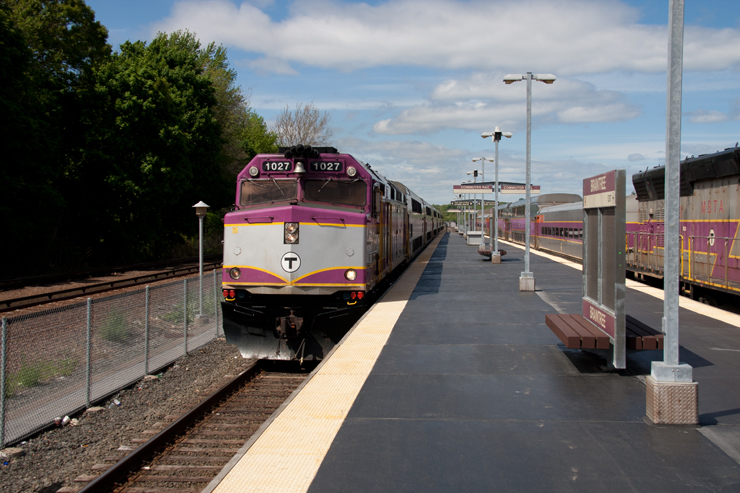FREETOWN, Mass. — Massachusetts Gov. Charlie Baker was among more than 40 politicians and government officials on hand Tuesday as the Massachusetts Bay Transportation Authority held a groundbreaking ceremony for its long-awaited South Coast Rail expansion project.
The project has been discussed for more than 25 years, and this was not the first time ground has been broken for the work to extend MBTA service to Fall River and New Bedford, Mass., the Providence Journal reports. But Baker noted that this time, the groundbreaking came as the extension has full funding and a completed construction plan.
“Those are really the two big things it didn’t have before,” Baker told the paper. “… And that basically guarantees it’s going to happen.” The state’s five-year capital plan has allocated $1 billion in funding for the project.
The project will require reconstruction of 17.3 miles of track and upgrading of 7.1 miles of existing track, as well as the building of six stations and two layover facilities. [See “Massachusetts commuter rail project clears funding, permit hurdles,” Trains News Wire, April 23, 2019.] Service is projected to begin in 2023.















And Doug, considering that the track space a passenger train takes up could also accommodate a freight train, which instead of taking a couple hundred people out of their cars could take a couple hundred _trucks_ off the road, which would be a better investment? And to be sure, yes I know that a run this short wouldn’t be worth running a freight train on, but it does illustrate that just getting cars off the road doesn’t always equate to reducing carbon emissions.
If transit REALLY wanted to make a difference, it would persuade everyone who wanted to live their lives in such that they lived in a place where they could take a train to work every single day to move to a city with an existing rail line connecting the two locations: massive housing accommodations, and a plaza of massive office buildings. The more people you can cram onto each train, and the fewer stops the train has to make, the more efficient the transit system would be.
DOUG You post “Anything to get cars off the highways, and reduce carbon emissions, is worth the public investment”. Anything? Anything? Lots of things the you DOUG advocate are worthwhile. But not “anything”.
DOUG – See ROBERT’s post. MBTA has needs up and down the line on its several existing routes. The Bristol County suburban rail extensions must be weighed against all of MBTA’s other capital project needs.
DOUG I’m not opposed to this extension but like any other public works project it has to be looked at to see if it’s the best use of available funding.
BTW DOUG how do you know this project will reduce carbon emissions?
Charles – This extension will not be electric. There is a mandate which requires electric service if the line ran south from Canton Jct and Stoughton to Taunton. As for running times, one glance at a map makes it clear that the route would be shorter and faster running directly from Taunton via Stoughton rather than making a detour over the Old Colony via Middleborough. But Governor “Good Time Charlie” Baker wants to get it done with no more lollygagging, so it will run via Middleborough. This is Phase 1; Phase 2, if it ever happens, will see the service moved to the Stoughton line and electrified.
Apparently this line is exempt from the policy requiring electriciation if the (nearby) Stoughton -Taunton gap were built. Does anyone in Massachusetts have an update?
Splitting trains on this Y-shaped service in effect halves the frequency (and doubles the headway) at the two endpoints, Fall River and New Bedford.
Also, what would be the difference in run time on this route (via Braintree- the Old Colony division) as opposed to if the Taunton gap were closed to the NEC via Canton Junction?
ROBERT – You ask the eternal question. There’s a whole lot of traffic on the ancient, obsolete Green Line that would like to see that billion dollars spent on them. You can’t please everybody or in today’s economy even come close.
Very possible that this money is earmarked for the expansion and cannot be used to upgrade/repair any of the existing facilities.
How far would that $1 billion go to fixing the MBTAs current problems rather than allocating it to another extension of this failing system.
Anything to get cars off the highways, and reduce carbon emissions, is worth the public investment.